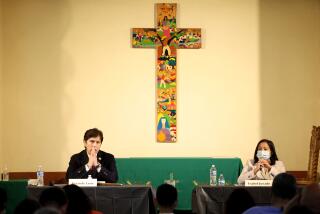SOAR Saga Isn’t Over; Vote Was Only a Start
- Share via
So is the SOAR war over?
For the tens of thousands of Ventura County residents who voted to approve the Save Open Space and Agricultural Resources initiatives on election day, it would seem so. Urban growth boundaries are in place in most cities and rural land can’t be altered without a vote. End of story.
And, in a certain way, that is what SOAR’s drafters had in mind. Ballot initiatives, by their very nature, are meant to be conversation-stoppers. Written without the benefit of legislative compromise, they are usually designed to be the final word on a topic--a blunt instrument used to promote one interest group’s point of view unilaterally.
But land use is a funny business. You can pass a ballot initiative, but you can’t stop the conversation.
Landowners, of course, never stop agitating to maximize their investments. But more important, the life of a community never stops changing. Businesses expand. New shopping trends emerge. People alter their daily work habits. And in California, of course, the population keeps growing. Even if you restrict new construction, you can’t freeze-dry a community.
That is why SOAR has to be viewed not as an end but as a beginning. As land-use policy, it must be seen simply as a way of defining the debate. Our communities will continue to grow and change. The voters have stated overwhelmingly that endless urban sprawl is not the way to accommodate that growth and change. So let’s talk about what we are going to do instead.
A lot of people, of course, won’t want to see it this way. Undoubtedly, many voters cast their ballots in favor of SOAR because they wanted to pull up the drawbridge--if you don’t build it, they won’t come--so they won’t want to be engaged in further discussions about how to accommodate growth. On the flip side, the landowners haven’t finished fighting the SOAR battle yet. To them, the electoral battleground will simply give way to the legal battleground, as lawsuit after lawsuit will be filed challenging SOAR.
Both these views, however, are unrealistic. On the one hand, we can’t simply pull up the drawbridge. No matter how individual voters feel, we must address growth and change in our communities. And on the other hand, we must get past the legal battleground. No matter whether landowners feel victimized, SOAR is almost certainly constitutional and most legal challenges are likely to fail.
Finally--and perhaps most important--SOAR is an overwhelming statement by the voters of Ventura County. Though it failed in Santa Paula, it passed everywhere else in the county with 60% to 70% of the vote.
So let’s get on with it. By accepting SOAR as the basis of our county land-use policy now--yet still recognizing that we must accommodate growth and change--we can prove once again that our county stands at the forefront of thoughtful land-use planning in the United States.
In this regard, the recent experience in the city of Ventura may be instructive. In 1995, Ventura voters approved a local version of the SOAR initiative. Although the initiative appeared to enjoy widespread public support at first, a strong anti-SOAR campaign almost turned the election the other way. After a nasty and divisive campaign, the Ventura SOAR passed with only about 53% of the vote. A bitter court battle followed, in which local landowners aggressively pursued every legal avenue but eventually lost all the way down the line.
Three years later, is Ventura still a bitterly divided community? Oddly enough, the answer is no.
Whatever SOAR’s pros and cons--and there are plenty of both--it has forced all the issues in Ventura:
* Because the city is no longer able to add housing by simply expanding onto agricultural land, Venturans have been forced to look at “infill” strategies that hold the potential to strengthen existing neighborhoods whose strength might otherwise be sapped by sprawl.
* Because it is clear that Ventura cannot compete with Camarillo in what might be called the “freeway retail” game, the city has been forced to examine how to use tourism, culture and its natural assets to foster business growth and a stable tax base.
These are but two of many examples.
Most remarkably, these new directions in Ventura have emerged as the result of a growing consensus among many people who were on opposite sides of the battlefield in 1995. The leaders of Ventura’s “visioning” process--a community-wide effort to chart a new direction for the city over the next decade or so--include people who were high-profile supporters and opponents of Ventura’s SOAR in 1995--and, indeed, were on opposite sides of the SOAR fence this fall. (Full disclosure: I am involved in the Ventura visioning process as a citizen but I took no part in pro- or anti-SOAR campaigns either in 1995 or this year.)
Perhaps the most amazing thing about the Ventura visioning process is that SOAR is simply a nonissue. Though the visioning debate is partly about land use--and, indeed, it was stimulated in part by SOAR’s passage in 1995-- SOAR itself rarely comes up. In Ventura, we have stopped fighting about it and simply accepted it as part of the policy landscape.
And maybe that is the best way for the county and the other cities to approach SOAR as well: not as something to defend or attack, but simply something to accept.
For more than 20 years, this county has retained its identity-- and served as a national trend setter--by pursuing innovative land-use policies about which most people in the county have agreed. There is no reason that any of that should change because of SOAR.
More to Read
Sign up for Essential California
The most important California stories and recommendations in your inbox every morning.
You may occasionally receive promotional content from the Los Angeles Times.










